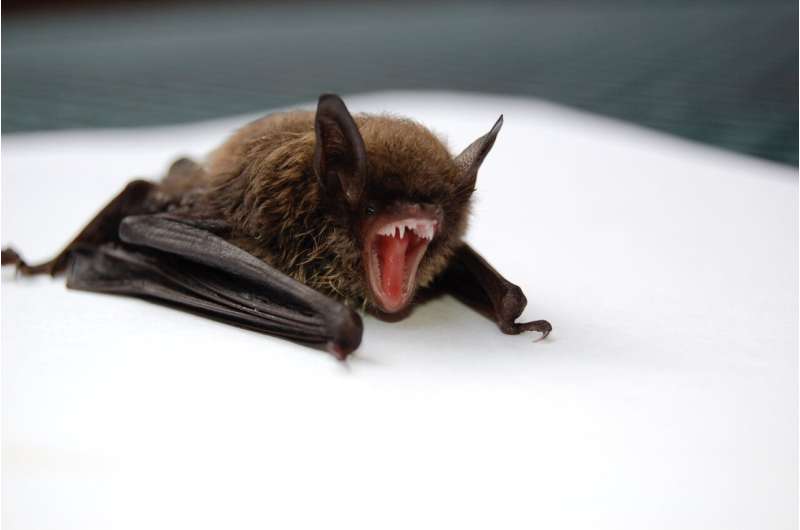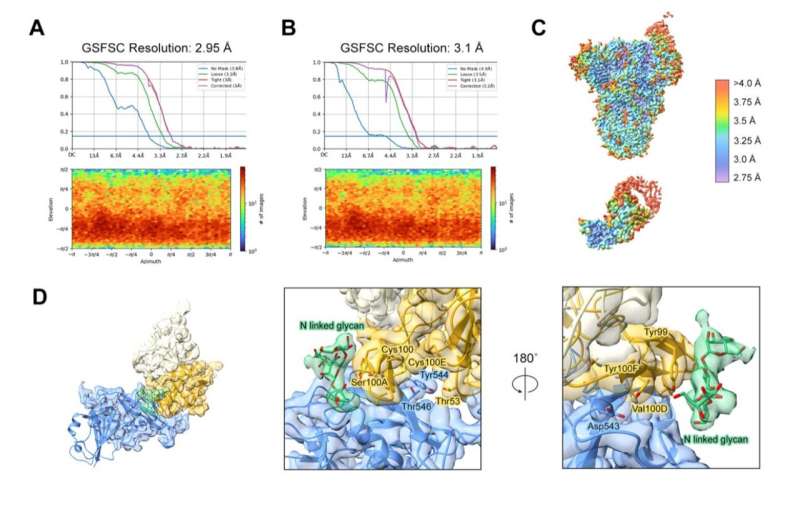October 30, 2023 feature
This article has been reviewed according to Science X's editorial process and policies. Editors have highlighted the following attributes while ensuring the content's credibility:
fact-checked
peer-reviewed publication
trusted source
proofread
Scientists isolate 'pre-emerging' bat coronavirus but also identify existing medication that potently neutralizes it

Repeated outbreaks of bat-derived coronaviruses among humans and other mammals have heightened the need for a broad range of therapeutics—monoclonal antibodies and antivirals—treatments that can come immediately "off-the-shelf" to address newly-emerging zoonotic threats.
A groundbreaking series of experiments by scientists at collaborating U.S. research centers has not only identified a "pre-emerging bat coronavirus," but investigators have additionally demonstrated that an off-the-shelf monoclonal antibody neutralized it potently. Additionally, in vitro tests of widely-used antivirals were also effective against the virus, researchers found.
The bat-derived coronavirus is more specifically known as BtCoV-422. And a neutralizing monoclocal antibody developed to treat Middle East respiratory syndrome coronavirus—MERS-CoV—has been available for years and is known as mAb JC57-11. MERS-CoV is a bat-derived zoonotic virus that infects dromedary camels, the animals that transmit the virus to people. BtCoV-422 is genetically similar to MERS-CoV.
Writing in Science Translational Medicine, investigators from Saint Louis University in Missouri worked with a team of scientists throughout the U.S. who underscored a deceptively simple principle: the types of countermeasures that have worked against other coronaviruses, such as MERS-CoV and SARS-CoV-2, should impact BtCoV-422. But while investigators found that most MERS-CoV–neutralizing monoclonal antibodies had very limited activity against the virus, mAb JC57-11 delivered a powerful one-two punch.
Preparedness is critical to avoid future pandemics, experts say, and among the goals of the World Health Organization is identifying potential pandemic viruses and developing strategies to blunt outbreaks before they start.
New coronaviruses have infiltrated human populations with episodic regularity throughout the 21st century: SARS CoV-1 in 2002, MERS-CoV in 2012 and SARS-CoV-2 in 2019. Others may emerge in the not-too-distant future, WHO scientists have predicted.
"The repeated emergence of zoonotic human betacoronaviruses dictates the need for broad therapeutics and conserved epitope targets for countermeasure design," asserted Dr. Longping V. Tse, a molecular virologist at Saint Louis University referring to the urgent need to identify the part of suspect viruses—the epitope—that the human immune system recognizes. "Middle East respiratory syndrome–related coronaviruses remain a pressing concern for global health preparedness," he added.
As Earth's only flying mammals, bats harbor a vast array of viruses that cause them no harm. Ebola, Marburg and Nipah viruses, along with multiple types of coronaviruses, have emerged from various bat species. Scientists attribute the animals' tolerance of otherwise deadly pathogens to a remarkable immune system. Bats live longer than other animals their size, thwart most infectious organisms, and rarely get cancer.
"Bats are a reservoir for a vast number of viruses that fuel zoonotic transmission of coronaviruses to other mammals, including humans," reported Tse, lead author of the new research. "Recently, a MERS-like coronavirus was isolated from pangolins, indicating the widespread host range of MERS-like coronaviruses." As with BtCoV-422, the pangolin-specific MERS-like coronavirus is considered a pre-emerging virus.

In experiments reported in Science Translational Medicine, Tse and colleagues analyzed BtCoV-422, and found that it has a 65% genetic sequence similarity with the receptor binding domain of MERS-CoV, a highly infectious coronavirus with a fatality rate in humans of 34.4%, according to the U.S. National Institutes of Health.
The research team analyzed BtCoV-422's adaptation pathways by investigating its ability to use the entry receptor known as DPP4. This protein stipples the surface of mammalian cells and serves as the doorway that BtCoV-422 unlocks to enter the cellular inner sanctum. Once inside the cell, the infection process unfolds.
SARS-CoV-2, by comparison, unlocks an entirely different doorway, entering cells by way of the ACE-2 receptor. BtCoV-422 uses DPP4 to gain entry into the cells of multiple species, including humans, Tse and colleagues found.
While the discovery of BtCoV-422 is an important find, the virus doesn't appear to be a threat at this time. "Further mutation-driven evolution would be required," for BtCoV-422 to gain the genetic capability to infect humans, Tse noted in his findings.
But while that may sound comforting, the virus has already found a way to efficiently hijack the DPP4 receptor. "We assessed replication efficiency of BtCoV-422 in multiple primary human cells, including airway epithelia, lung fibroblasts, and lung endothelial cells," Tse wrote.
Scientists found that BtCoV-422 replicated efficiently in primary human airway, lung endothelial, and fibroblast cells, although less efficiently than MERS-CoV.
"We then tested current countermeasures," Tse added, which in addition to monoclonal antibodies included antiviral drugs and vaccine-elicited murine serum. Several antivirals, Remdesivir, Paxlovid and Lagevrio, an investigational nucleoside analog medication currently used to treat mild to moderate COVID-19.
All demonstrated potent inhibition against BtCoV-422 in vitro. Serum from mice that received a MERS-CoV mRNA vaccine showed reduced neutralizing activity against BtCoV-422.
The large research team included scientists from the Marsico Lung Institute and other divisions of the University of North Carolina at Chapel Hill; the National Institute of Allergy and Infectious Diseases in Bethesda, Maryland, and the University of Texas at Austin.
"Our research objective was to understand the potential of BtCoV-422 in infecting clinically relevant human airway cultures and testing potential antivirals and antibodies against BtCoV-422," Tse concluded.
More information: Longping V. Tse et al, A MERS-CoV antibody neutralizes a pre-emerging group 2c bat coronavirus, Science Translational Medicine (2023). DOI: 10.1126/scitranslmed.adg5567
© 2023 Science X Network


















